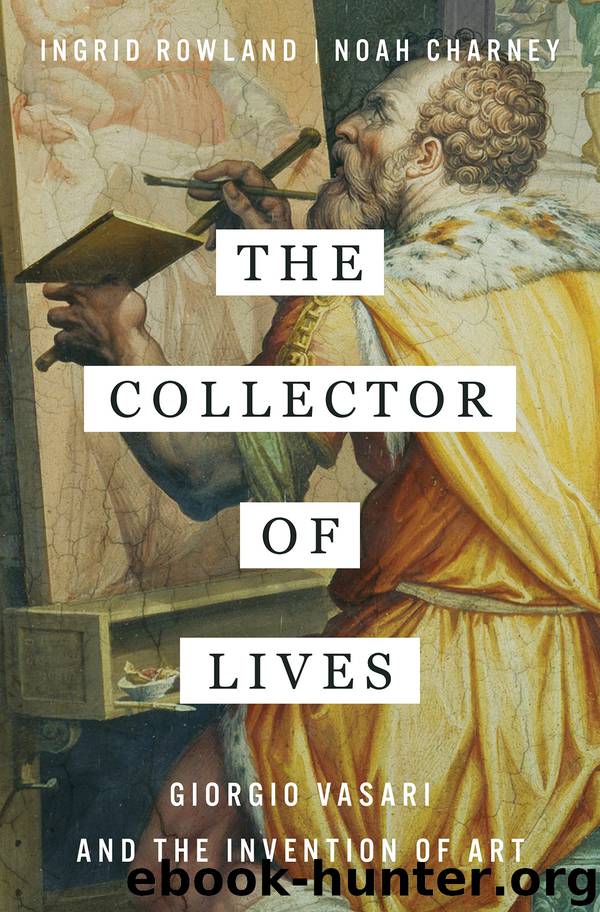The Collector of Lives by Ingrid Rowland

Author:Ingrid Rowland
Language: eng
Format: epub
Publisher: W. W. Norton & Company
HOWEVER GREAT HIS ARTISTIC PROWESS, Michelangelo was never generous with either his money or his praise; in fact, he was downright stingy. By contrast, Bindo Altoviti, handsome and magnanimous, was one of the most discerning patrons of the sixteenth century. Giulio Romano, for all his irreverence, was the dominant figure in Raphael’s workshop, the man Raphael treated as if he were a son, and not simply a gifted assistant. Ottaviano de’ Medici, discreetly working behind the scenes in Florence, was the arbiter of taste for his entire family. However little these men had in common, they all agreed that Giorgio Vasari was both an excellent artist and an excellent companion. Clearly they saw something in him, and in his work, that our own era does not appreciate to the same extent. Unlike modern critics, Giorgio’s contemporaries did not consider him a second-rate practitioner; instead, they entrusted him with the greatest responsibilities an artist could take in hand: magnificent public projects and intensely private devotional works.
Tastes change, for individuals and for societies at large. At the beginning of the twentieth century, most people who cared about such things regarded the work of painters like Bronzino, Pontormo, Rosso Fiorentino, Vasari, and Caravaggio as ugly beyond redemption. Today, a century later, visitors to the Vatican Palace exclaim over Michelangelo’s work in the Pauline Chapel, but pass quickly over Vasari’s frescoes in the Sala Regia next door. They would no longer be described as ugly, but while Caravaggio has shot to prominence in recent decades, thanks to (rather than in spite of) his revolutionary aesthetic, which viewers once found off-putting, Vasari remains marginalized, considered by many to have been an important historian, but a decidedly derivative painter. Typically, Robert Carden’s 1911 biography, the only extensive biography of Vasari to date, buries his subject beneath a heap of negative judgments except, grudgingly, to praise him as a writer. Visitors to Florence dream of pulling down his great battle scenes in the Palazzo Vecchio to find out whether anything remains beneath them of the Leonardo’s Battle of Anghiari or Michelangelo’s Battle of Cascina. Only two places in Italy still take real, uncomplicated pride in their surviving works by Giorgio Vasari: Arezzo, his birthplace, and Naples, where his decorations for the church of Monteoliveto Maggiore are treasured by the people who keep them constant company. Ironically for someone who wrote so acutely on evaluating works of art, Vasari seems to have fallen victim to changing definitions of good, bad, and beautiful.
The most essential of these changes in opinion may well be the modernist conviction that art should be direct, simple, and honest, rather than studiously artificial—and there is no art more studious and artificial than Mannerism. This criterion of simple directness had already come into play at the end of Vasari’s life, in 1563, when the Catholic Church, at the close of its reforming Council of Trent, issued general guidelines for the creation of religious art, architecture, and music. Both the words accompanied by sacred music and
Download
This site does not store any files on its server. We only index and link to content provided by other sites. Please contact the content providers to delete copyright contents if any and email us, we'll remove relevant links or contents immediately.
Cecilia; Or, Memoirs of an Heiress — Volume 3 by Fanny Burney(31471)
Cecilia; Or, Memoirs of an Heiress — Volume 2 by Fanny Burney(31420)
Fanny Burney by Claire Harman(26257)
We're Going to Need More Wine by Gabrielle Union(18647)
Plagued by Fire by Paul Hendrickson(17119)
All the Missing Girls by Megan Miranda(14802)
Cat's cradle by Kurt Vonnegut(14784)
Bombshells: Glamour Girls of a Lifetime by Sullivan Steve(13703)
Leonardo da Vinci by Walter Isaacson(12817)
4 3 2 1: A Novel by Paul Auster(11820)
For the Love of Europe by Rick Steves(11576)
Adultolescence by Gabbie Hanna(8600)
The remains of the day by Kazuo Ishiguro(8418)
Note to Self by Connor Franta(7460)
Diary of a Player by Brad Paisley(7272)
Giovanni's Room by James Baldwin(6830)
What Does This Button Do? by Bruce Dickinson(5938)
Born a Crime by Trevor Noah(5103)
Ego Is the Enemy by Ryan Holiday(4968)
